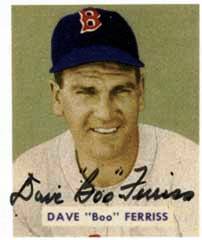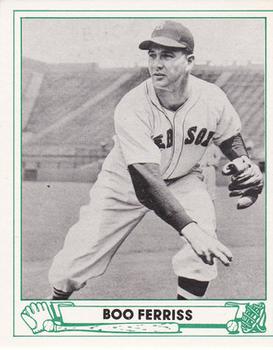May 27, 1945: Boo Ferriss one-hits White Sox for sixth consecutive win

 Dave “Boo” Ferriss, an ex-G. I. discharged from the Army Air Corps in February 1945, began his major league career with an astonishing eight consecutive wins in 1945. The start of his career was as unlikely as any player before him, since he had minimal time as a professional player prior to his debut.1 In his first five starts for the Boston Red Sox, Ferriss hurled three shutouts and two additional complete games, including a record 22 1/3 consecutive scoreless innings.
Dave “Boo” Ferriss, an ex-G. I. discharged from the Army Air Corps in February 1945, began his major league career with an astonishing eight consecutive wins in 1945. The start of his career was as unlikely as any player before him, since he had minimal time as a professional player prior to his debut.1 In his first five starts for the Boston Red Sox, Ferriss hurled three shutouts and two additional complete games, including a record 22 1/3 consecutive scoreless innings.
Pitching on three days’ rest for the first time in his brief career, Ferriss drew the starting assignment against the Chicago White Sox in the first game of a Sunday doubleheader on May 27. The right-hander was facing the White Sox for the second time of the season, having shut them out in the first encounter, 2-0.
The White Sox were entering the game in third place in the standings, with five games separating them and the sixth-place Red Sox. Left-hander Eddie Lopat (2-2) was the starting pitcher for the White Sox on a day in which an estimated twenty-seven thousand over coated fans attended at Fenway Park.
Ferriss had a good outing against the White Sox in his shutout win against them on May 18, but his performance on May 27 was even better. He allowed only one hit while facing 28 batters. The only other baserunners came via a walk and an error.
The lone hit off of Ferriss came in the 2nd inning by Tony Cuccinello. Left-fielder Bob Johnson came close to catching Cuccinello’s hit with a sliding catch attempt.2Mike Tresh drew the lone walk in the 3rd inning. Then after Oris Hockett reached base on an error by Ben Steiner in the 4th inning, Ferriss retired the last 17 batters in order.
On the other hand, the Red Sox banged out thirteen hits and seven runs against Lopat, who lasted six innings.
The Red Sox scored three runs in the 1st inning on four singles and a walk, with Pete Fox and Jack Tobin accounting for the RBIs. In the 4th inning, the Red Sox scored two more runs on RBI doubles by Tom McBride and Bob Johnson. Their final two runs occurred in the 6th inning on a sacrifice fly by Tobin and Bob Garbark’s flyball on which the White Sox center fielder made an error. McBride led the Red Sox with three hits.
The 7-0 win by Ferriss continued his mastery over American League opponents. His ERA was an astounding 0.50 (51 scoreless innings in 54 innings pitched) after his fourth shutout and sixth consecutive victory.
Ferriss’s impressive start to his career recalled another sensational rookie performance by Harry Krause of the Philadelphia A’s in 1909. Krause recorded ten straight victories to start the season, including six shutouts and four complete games. During his streak, he yielded only five runs. However, one difference from Ferriss’s feat was that Krause actually pitched in four games for the A’s in his debut season the season before.3
At midseason Ferriss was on pace for a 30-win season, but he struggled with asthma and had to settle for a 21-10 record. Many observers surmised that Ferriss’s success in 1945 was due in large part to having faced weak lineups of opposing teams because of the shortage of experienced players during the war.
However, Ferriss proved he was no fluke by winning 25 games in 1946 when all of the soldiers had returned from the war and team rosters were largely restored with its prewar players. He would lead the American League with a winning percentage of .806, while helping the Red Sox to their first pennant since 1918.
Ferriss’s career was cut short by an arm injury suffered during the 1947 season. Consequently, he would make only nine major league starts from 1948 to 1950. He was the pitching coach for the Red Sox from 1955 to 1959. Despite his shortened career, he was elected to the Boston Red Sox Hall of Fame in 2002.
Sources
In addition to the sources mentioned in the notes, the author also consulted: Baseball-Reference.com and Retrosheet.org websites; Marc Z. Aaron’s and Bill Nowlin’s Who’s on First: Replacement Players in World War II (Phoenix: Society for American Baseball Research, 2015); Rick Cleveland’s; Boo: A Life in Baseball, Well-Lived (Canada: Piedmont Publishing, 2008); David Pietrusza’s, Matthew Silverman’s and Michael Gershman’s Baseball: The Biographical Encyclopedia (New York: Total/Sports Illustrated, 2000) and Melville Webb’s “Ferriss Pitches One-Hitter,” Daily Boston Globe, May 28. 1945: 5.
Notes
1Prior to his major league debut, Ferriss’s minor-league career consisted solely of 130 innings with Greensboro of the Class B Piedmont League in 1942, when Ferriss was age 20. He was in military service in 1943 and 1944, then got off to his remarkable start in 1945 as a major-league rookie
2 Jack Malaney. “Hub Tosses Up Hats Over Cooper, Ferriss,” The Sporting News, May 31, 1945: 1.
3 “Dave Ferriss’ Splash Recalls Krause’s Record String in ’09,” The Sporting News, May 31, 1945: 6
Additional Stats
Boston Red Sox 7
Chicago White Sox 0
Fenway Park
Boston, MA
Box Score + PBP:
Corrections? Additions?
If you can help us improve this game story, contact us.


